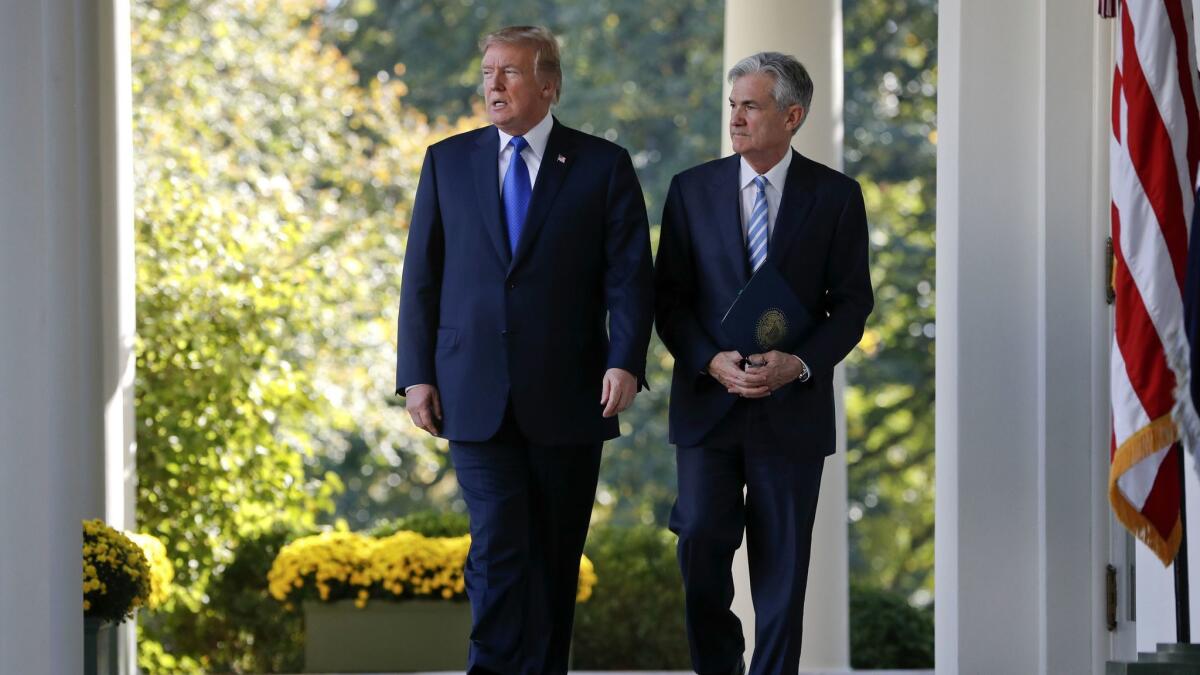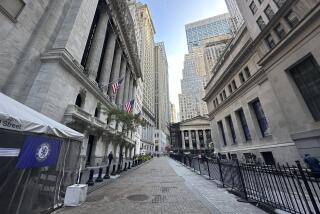Trump escalates his criticism of Federal Reserve interest rate hikes

Reporting from Washington — Before this week, it had been more than a quarter-century since a sitting U.S. president publicly pressured the independent Federal Reserve on interest rates.
On Friday, President Trump did it for the second day in a row.
In unprecedented back-to-back statements, Trump escalated his criticism of the nation’s central bankers for, in his view, hurting the economy by continuing to inch up their benchmark rate in a process known as monetary policy tightening.
After saying Thursday in a CNBC interview excerpt that he was “not thrilled” by the Fed’s recent rate increases, Trump took to Twitter on Friday morning to say the hikes were “taking away our big competitive edge” with China and the European Union.
“The United States should not be penalized because we are doing so well. Tightening now hurts all that we have done,” Trump tweeted. “… Debt coming due & we are raising rates — Really?”
Analysts essentially reacted the same way — really? — in response to the rare public criticism of the Fed from a sitting president.
They questioned Trump’s understanding of monetary policy and global economics while warning of the danger of the Fed making interest rate decisions based on short-term political calculations instead of what’s best for the economy over the long term.
Trump’s comments were even more confounding because he handpicked Fed Chairman Jerome H. Powell and referred to him in the CNBC interview as “a very good man.”
“I guess the good man’s not doing what he wants,” said Chris Rupkey, chief financial economist at MUFG Union Bank in New York and a close follower of the Fed. “Very plainly, he’s not in favor of rates going higher. It’s very explicit.”
After the CNBC comments aired Thursday, the White House issued a statement saying Trump respected the Fed’s independence and “is not interfering with Fed policy decisions.”
But then Trump doubled-down on his criticism on Friday, raising concerns he was launching a campaign to pressure the Fed.
“The average person in the street obviously will agree. Nobody likes high interest rates,” said Sung Won Sohn, chief economist at SS Economics, an economic consulting firm in Los Angeles. “But a president making such a statement I think is unfortunate.”
The last time a sitting president publicly pressured the Fed on interest rates was in June 1992.
President George H.W. Bush, who was in a tough reelection battle in the wake of a recession, told the New York Times, “I’d like to see another lowering of interest rates. … I can understand people worrying about inflation. But I don’t think that’s the big problem now.”
The Fed, under then-Chairman Alan Greenspan, cut the benchmark federal funds rate by 0.5 percentage points the next week, and again by 0.25 percentage points in September.
Bush lost the election anyway. In a 1998 interview, Bush blamed the defeat on Greenspan, saying he “disappointed” him by not lowering interest rates more dramatically coming out of the 1990-91 recession.
But such public criticism has been rare since the Fed was created in 1913 as the nation’s independent central bank.
The president nominates the seven members of the Fed’s Board of Governors, who must be confirmed by the Senate. They serve 14-year terms and can only be removed for cause, not at will like most other presidential appointees. The chairman serves a four-year term.
Presidential pressure on the Fed, when it has come, usually has been done behind the scenes.
For example, White House tape recordings show that President Nixon pressured Fed Chairman Arthur Burns to keep interest rates low to boost Nixon’s reelection chances in 1972. Burns did, but it’s not clear if it was because of the pressure.
Presidents typically steer clear of public comments to preserve the Fed’s independence, which is crucial to investor confidence in their actions.
“History has shown that central banks with independence have done a much better job of controlling inflation without sacrificing economic growth,” Sohn said.
“Central banks with intervention from the executive branch, such as Argentina, Brazil and some Asian and African countries, have done poorly in controlling inflation and hurt economic growth,” he said.
Central banks raise interest rates to prevent high inflation by keeping the economy from overheating.
The Fed has been inching up interest rates recently because the U.S. economy is doing better. Trump frequently boasts about the economic improvements, even exaggerating, as he did in the CNBC interview, that “it’s maybe as good as it’s ever been.”
In his Fed comments, Trump complained that the higher interest rates, which still are historically low, are pushing up the value of the dollar.
Foreign investors are attracted to countries that pay higher interest rates, spiking demand for the country’s currency. However, a stronger dollar makes U.S. goods more expensive overseas, hurting exports. At the same time, the Chinese currency has fallen, which makes its exports cheaper around the world.
Economists pointed out that part of the reason China’s currency has dropped recently is the trade war Trump has started with them.
He escalated that battle Friday by reiterating a threat he made this month to slap tariffs on all of the roughly $500 billion in Chinese goods the U.S. imports each year.
“I’m ready to go to 500,” he told CNBC when asked about the threat.
China is more dependent on exports than the United States, so the value of its currency is declining because of investor concerns about the negative impact of the trade war on the county’s economy. Chinese officials also probably are acting to devalue the currency to help boost exports, Rupkey said.
Trump’s comments about the Fed helped push the value of the dollar down Friday.
Analysts don’t expect Powell to give in to the pressure. He has pledged in the past to be independent and Trump cannot remove him for rate-hike decisions.
“We’re going to do our business in a way that’s strictly nonpolitical, without taking political issues into consideration, and that carries out the mandate Congress has given us,” Powell said in an interview on the “Marketplace” radio show last week.
Trump can influence the Fed mostly through appointments to the seven-member Fed board. Two of the three sitting Fed governors were Trump picks. Two other nominees are awaiting Senate confirmation. And Trump has two other seats to fill.
Rates are set by the 12-member Federal Open Market Committee, which includes the seven Fed governors as well as five regional bank heads who are not chosen by the president. They are selected by the regional bank boards with approval from the Fed governors in Washington.
“I can’t imagine Jerome Powell and other members of the FOMC changing their views based on what the president has said,” Sohn said.
Rupkey isn’t so sure given that Fed officials appear closely split over whether they will inch up rates one or two more times this year.
“It’s going to be in the back of their minds and I wouldn’t be surprised if the gradual rate hikes become less gradual,” he said.
Twitter: @JimPuzzanghera
More to Read
Inside the business of entertainment
The Wide Shot brings you news, analysis and insights on everything from streaming wars to production — and what it all means for the future.
You may occasionally receive promotional content from the Los Angeles Times.











